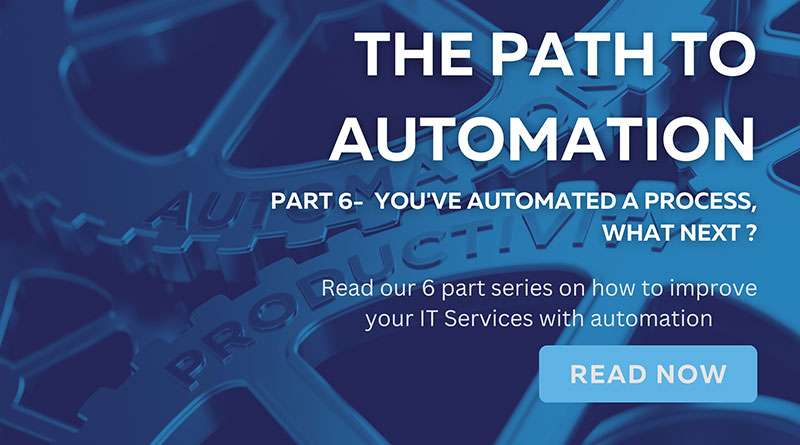The Path to Automation, part 6: It’s automated. What’s next?
Once you’ve automated your first process… hold on! Don’t fall into the trap of rushing headlong into the next one.
The single most important thing you can do now is wait. That is, wait until you’ve had time to run the reports that will tell you whether the automation is working as intended. For example, is it delivering the time-saving benefit you’d hoped for?
We’ve recently been working with a large organisation that implemented its own password reset tool, and was getting up to 1,000 requests per week. But the tool wasn’t logging this, so they had no idea how much time it was saving the business. And because they couldn’t report on it, it was hard to make the case for further investment in automation.
Fortunately, they soon realised this was a problem, started running reports and it was full steam ahead after that.
There is, of course, a chance that your reports won’t deliver good news. You may find that the automation isn’t delivering the benefits you were expecting. If that’s the case, it’ll usually be a technical problem (assuming your initial assessment of demand, time-saving and so on were correct in the first place).
The other likelihood is that you might not have considered all the real-world possibilities at the planning stage. For example, you may have assumed that your customers always request something a certain way. But, in reality, they actually do it in three different ways. If you’ve missed two of those three, there’s obviously going to be a gap – in other words, they’ll still be relying on the manual process for those other two ways and the automation will only be saving you a fraction of the time you expected.
But if your reporting indicates that everything is working well and delivering the benefits that you’d been hoping for, it’s time to give yourself a pat on the back. Then, in the spirit of continual service improvement, get ready to move on to the next process and ask yourself: what’s your next biggest win?
Here, you should go back to the first stage in the decision-making process, where you evaluate your data and run your report again. That’s because, in the fast-moving world of business and IT, things might well have moved on in the time you’ve been working on your first process. For example, your most popular requests might have changed because of a shift in the business.
Also, flushed with the joy of a first success, it’s tempting to become over-confident and try to do too much too quickly – for example, by planning to automate multiple processes simultaneously in the second wave. However, we’d always advise sticking to a linear approach rather than ending up in a situation where you overstretch and disappoint your customers by only delivering half of what you hoped for.
And another watch-out: don’t be tempted to move onto the next process until you’ve had the full report from the first one, as you might find it’s not working as well as you thought (see above).
While you’re waiting for that data to roll in, it might be worth doing some discovery in preparation for the next project. But don’t start investing serious time and money into it – as you may need to use this resource to fix the first project.
We’ve seen too many failed automation processes left languishing because teams are too busy to fix them as they’ve already moved onto the next one. And they can’t stop because they’ve promised delivery to their customers, meaning that pausing to take a step back would leave them in an awkward situation.
But once you’ve run that report and – hopefully – all is well… you’re ready to roll with the next process.
Then, it’s just a case of following the process again, and keeping on going. Happy automating!
This is the final part in our series of articles about automation. To start at the beginning, click here.
We hope you’ve found our series of articles useful. If so, please get in touch for a no-strings chat about how we can help your organisation reap the benefits of automation.



